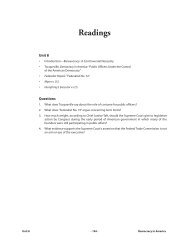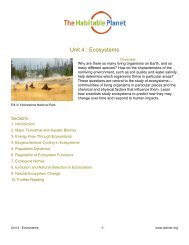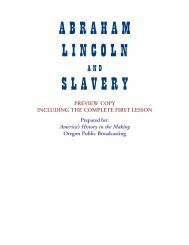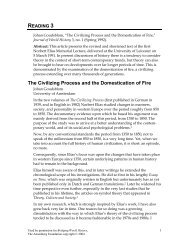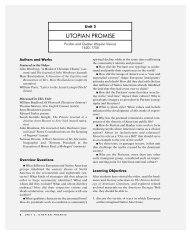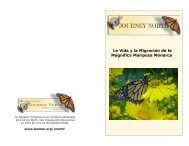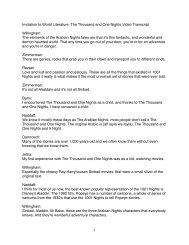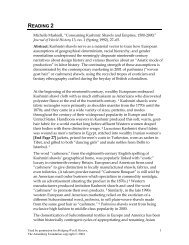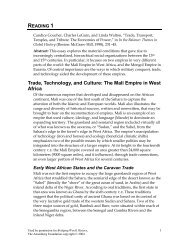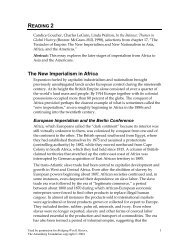Workshop 6 Literature, Art, and Other Disciplines
Workshop 6 Literature, Art, and Other Disciplines
Workshop 6 Literature, Art, and Other Disciplines
Create successful ePaper yourself
Turn your PDF publications into a flip-book with our unique Google optimized e-Paper software.
<strong>Workshop</strong> 6<br />
<strong>Literature</strong>, <strong>Art</strong>, <strong>and</strong> <strong>Other</strong> <strong>Disciplines</strong><br />
“One of the problems with integrating literature [<strong>and</strong>] other domains is the belief that there has to be<br />
some gr<strong>and</strong>iose formal plan. And there does not. It can be very impromptu.”<br />
—Dorothy Franklin, Seventh-Grade Teacher, DeWitt Clinton Elementary School, Chicago, Illinois<br />
Description<br />
Across the country, teachers are offering students doorways into literature via the visual arts, dramatic activities,<br />
<strong>and</strong> music. In addition, increasing dissatisfaction with curricular fragmentation is leading teachers to discover<br />
ways to make connections across subject areas. Teachers <strong>and</strong> students alike find such integration effective in a<br />
number of ways.<br />
Asking students to think about their literary experiences in a variety of forms leads to fresh insights <strong>and</strong> new<br />
underst<strong>and</strong>ings of a text. Encouraging them to represent those underst<strong>and</strong>ings in a variety of forms offers access<br />
to representations that might not be available verbally while offering less verbal students multiple ways to<br />
demonstrate knowledge.<br />
Connecting the study of literature to subjects across the curriculum enriches both subject areas. Such connections<br />
reinforce related concepts across disciplines, provide fuller underst<strong>and</strong>ings by revisiting concepts or topics<br />
from different disciplinary perspectives, give students more coherent learning experiences <strong>and</strong> leads them to<br />
coordinate the tools used in different disciplines when tackling complex problems.<br />
Offering students the opportunity to read historical fiction, topical poetry <strong>and</strong> essays, or even nonfiction works<br />
such as diaries <strong>and</strong> letters, often enables students to imagine the human concerns behind historical events. Connections<br />
between literature <strong>and</strong> math or science exp<strong>and</strong> student underst<strong>and</strong>ings of both areas while broadening<br />
habits of mind. Students who experience a range of such connections learn to establish relationships between<br />
<strong>and</strong> among seemingly contrary ways of defining <strong>and</strong> explaining the world.<br />
Key Points<br />
• The visual arts, music, <strong>and</strong> drama provide effective ways for students to develop literary envisionments.<br />
• Teachers are integrating history, social studies, science, <strong>and</strong> even math with literary experiences.<br />
• Students benefit cognitively when they are exposed to various art forms while studying literature. <strong>Art</strong>,<br />
drama, <strong>and</strong> music enable students to explore their literary underst<strong>and</strong>ings more deeply <strong>and</strong> exp<strong>and</strong> their<br />
thinking about texts.<br />
• Integrating social studies, history, <strong>and</strong> science with literature study helps students by adding a human<br />
dimension to the content of the other subject. Embedding literature study in the context of social studies,<br />
history, or science helps students exp<strong>and</strong> their literary underst<strong>and</strong>ings.<br />
• <strong>Art</strong>, drama, <strong>and</strong> music can provide different points of entry into literature, especially for students with<br />
diverse learning styles.<br />
• The arts can provide realistic or metaphorical representations of literary meanings.<br />
• To maximize their value in the literature classroom, art, drama, <strong>and</strong> music should be integral to literature<br />
study, not just seen as add-ons.<br />
• <strong>Art</strong> provides students with another way to talk about their literary underst<strong>and</strong>ings.<br />
Making Meaning <strong>Workshop</strong> - 59 - <strong>Workshop</strong> 6
• Visual art, drama, <strong>and</strong> music provide additional ways for teachers to see students thinking about a literary<br />
text as well as a way to help students develop their underst<strong>and</strong>ings.<br />
• The arts elevate literacy comprehension <strong>and</strong> further envisionment-building because they force students to<br />
shuttle back <strong>and</strong> forth between their literary underst<strong>and</strong>ings <strong>and</strong> their artistic creations.<br />
• Having students dramatize characters or situations helps further their underst<strong>and</strong>ings. Skits, role-playing,<br />
<strong>and</strong> other dramatic activities help students underst<strong>and</strong> characters <strong>and</strong> the situations they are in.<br />
• Dramatic activities provide excellent ways for students to share what they have read with one another.<br />
• Convincing administrators, parents, <strong>and</strong> other teachers of the value of integrating the arts in the literature<br />
classroom can be difficult; others may view the arts as non-essential, or even frivolous.<br />
• The arts can help students develop their sense of imagery, an important aspect of envisionment-building.<br />
• Social studies <strong>and</strong> history are often paired with literature because literature offers new ways of seeing<br />
historical periods <strong>and</strong> events.<br />
• Contextualizing literature with social studies <strong>and</strong> history enriches the study of the literature.<br />
Learning Objectives<br />
After viewing this program, you will be able to:<br />
• consider experiences that ask students to integrate literature with art, music, <strong>and</strong>/or drama.<br />
• consider effective pairings between literary texts <strong>and</strong> content area topics in social studies, history, science,<br />
<strong>and</strong>/or mathematics.<br />
Background Reading<br />
In preparation for this workshop, review “<strong>Literature</strong> Across the Curriculum” in Dr. Judith Langer’s Envisioning<br />
<strong>Literature</strong> from the Teachers College Press. Copyright 1995. ISBN 0-8077-3464-0.<br />
You may also be interested in the panelists’ professional biographies found in the About the Contributors section<br />
of this guide.<br />
For additional online resources, go to www.learner.org/envisioningliterature. Select Making Meaning in <strong>Literature</strong>:<br />
A <strong>Workshop</strong> for Teachers, Grades 6–8, click on <strong>Workshop</strong> 6, <strong>and</strong> go to Additional Reading.<br />
<strong>Workshop</strong> 6 - 60 - Making Meaning <strong>Workshop</strong>
<strong>Workshop</strong> Session (On-Site)<br />
Getting Ready (30 minutes)<br />
In this video, you will hear the workshop teachers discussing ways in which they integrate literature <strong>and</strong> the arts<br />
in order to enhance their students’ literary experiences. Additionally, they share ways they connect literature to<br />
other curricular areas in order to offer students richer learning experiences. As you listen, think about your<br />
students <strong>and</strong> your curriculum. How might you use the arts to enhance literature study? How might the inclusion<br />
of literary texts exp<strong>and</strong> students’ underst<strong>and</strong>ings <strong>and</strong> appreciation in other curricular areas?<br />
Discuss:<br />
Discuss the following questions:<br />
• Have you ever incorporated art, music, or<br />
drama into literary study in your classroom? In<br />
what ways? What were the results?<br />
• Have you ever created thematic connections<br />
between the study of literature <strong>and</strong> content<br />
areas such as social studies, history, science or<br />
math? In what ways? What were the results?<br />
Reflect in <strong>Workshop</strong> Journals:<br />
Respond to the following in your workshop journal:<br />
• Choose a specific text that you teach. Brainstorm as many ways as possible that you could incorporate art,<br />
music, or drama in its study or explore ways you might connect it to content area themes that your students<br />
encounter in other areas of study.<br />
Watch the <strong>Workshop</strong> Video (60 minutes)<br />
Think About <strong>and</strong> Discuss:<br />
Pause just before the title card “<strong>Literature</strong> <strong>and</strong> the<br />
Visual <strong>Art</strong>s.”<br />
• What different art forms are your students particularly<br />
receptive to? How might you integrate<br />
these into literature study?<br />
• What art forms do you enjoy <strong>and</strong> feel comfortable<br />
with? Are there ways you might share your<br />
expertise by connecting it to literary study?<br />
• What are some of the key topics your students<br />
encounter in curricular areas other than<br />
English/language arts? What literary texts do<br />
you know that might connect to those areas?<br />
• What questions or thoughts are raised as you<br />
watch the video?<br />
Site Leader: Use these questions to spark discussion<br />
before viewing the workshop program. Participants<br />
may write answers to the reflection questions in their<br />
journals, as time permits. You may use all of the questions<br />
or select only a few.<br />
If you have Internet access, display the workshop<br />
Web site at www.learner.org/envisioningliterature,<br />
making participants aware of online resources <strong>and</strong><br />
interactive opportunities.<br />
Site Leader: If you are watching on videocassette,<br />
you may pause at the segments indicated here to<br />
give participants opportunities to discuss, reflect,<br />
<strong>and</strong> interact with the program. If needed, rewind <strong>and</strong><br />
replay segments of the program so that viewers can<br />
thoughtfully examine all pertinent information. If you<br />
are watching a real-time broadcast, ask participants<br />
to consider the questions as they view the program,<br />
<strong>and</strong> discuss them later.<br />
You may select any or all of the questions to discuss,<br />
as time permits <strong>and</strong> according to the interests of your<br />
participants.<br />
Making Meaning <strong>Workshop</strong> - 61 - <strong>Workshop</strong> 6
<strong>Workshop</strong> Session, cont’d.<br />
Pause just before the title card “<strong>Literature</strong> <strong>and</strong> Drama.”<br />
• How might you use the visual arts to support the learning of your less verbal students?<br />
• What questions or thoughts are raised as you watch the video?<br />
Pause just before the title card “<strong>Literature</strong> <strong>and</strong> Music.”<br />
• What dramatic activities might be particularly effective for your students? How could you connect them to<br />
specific literary texts that they read?<br />
• What questions or thoughts are raised as you watch the video?<br />
Pause just before the title card “<strong>Literature</strong> <strong>and</strong> Social Studies.”<br />
• What musical experiences might you offer to enrich students’ developing envisionments of a text?<br />
• What are some creative writing invitations that you have found effective as ways to exp<strong>and</strong> student underst<strong>and</strong>ing<br />
of a literary work?<br />
• What questions or thoughts are raised as you watch the video?<br />
View program until the end.<br />
• How might the addition of literature to topics in history or social studies benefit students?<br />
• How might the study of history or social studies enrich students’ underst<strong>and</strong>ings of a literary text?<br />
• What questions or thoughts are raised as you watch the video?<br />
Going Further (30 minutes)<br />
Work in Groups:<br />
In groups:<br />
• list a number of ways to combine your assigned<br />
area with the study of literature.<br />
• identify the value(s) of such combinations for<br />
students <strong>and</strong> for a teacher.<br />
• identify the challenges of implementing such<br />
combinations effectively.<br />
• suggest management strategies to support<br />
effective integration.<br />
Site Leader: Divide the participants into groups of<br />
three to five, asking each group to choose one of the<br />
following areas for discussion (you may assign topics<br />
if you wish): the visual arts, drama, music, or another<br />
curricular area (such as history, social studies, science,<br />
or math).<br />
<strong>Workshop</strong> 6 - 62 - Making Meaning <strong>Workshop</strong>
Between Sessions (On Your Own)<br />
Homework Assignment<br />
Journal:<br />
Respond to the following in your workshop journal:<br />
• What are the particular strengths <strong>and</strong> talents you observe in your student population? What are some ways<br />
you can take advantage of those abilities to enrich their thinking <strong>and</strong> learning about literature?<br />
Reading:<br />
In preparation for <strong>Workshop</strong> 7, read “Ongoing Assessment: Evolving Goals” in Dr. Judith Langer’s Envisioning<br />
<strong>Literature</strong> from the Teachers College Press. Copyright 1995. ISBN 0-8077-3464-0.<br />
For additional online resources, go to www.learner.org/envisioningliterature, select Making Meaning in <strong>Literature</strong>:<br />
A <strong>Workshop</strong> for Teachers, Grades 6–8, <strong>and</strong> look under Additional Reading for <strong>Workshop</strong> 7.<br />
Ongoing Activity<br />
Channel-Talk:<br />
You are encouraged to participate in an email discussion list called Channel-Talk. Send comments <strong>and</strong> questions<br />
regarding the workshop to other participants around the country. Comments can also be viewed on the Web site.<br />
Go to www.learner.org/envisioningliterature, select Making Meaning in <strong>Literature</strong>: A <strong>Workshop</strong> for Teachers, Grades<br />
6–8, <strong>and</strong> click on Channel-Talk.<br />
Extension: Classroom Connection<br />
Teacher as a Reflective Practitioner:<br />
Many administrators <strong>and</strong> parents undervalue integrating the arts in the literature curriculum. Brainstorm a list of<br />
reasons for such attitudes. Then list the arguments you might use if called upon to justify the inclusion of activities<br />
such as art, drama, or music in your classroom. How might you convince such critics that these activities are<br />
not frivolous add-ons, but rather useful tools for extending student thinking about literary texts?<br />
Student Activities:<br />
Try this activity with your students. Choose a short piece of literature such as a poem. Divide your students into<br />
groups <strong>and</strong> ask each group to choose one of the following presentations:<br />
1. create a dramatic reading of the poem using your voices—individually or in unison—to present the poem’s<br />
meaning(s) to the class.<br />
2. set the poem to music <strong>and</strong> prepare to sing it to the class.<br />
3. create <strong>and</strong> perform a dance that conveys the poem to the class.<br />
4. choose another mode of presentation that involves rhythm, music, <strong>and</strong>/or dance.<br />
Divide the class into groups. Give each group a different short script. Ask them to prepare a Reader’s Theater presentation<br />
of their script, limiting their acting to verbal interpretation <strong>and</strong> brief h<strong>and</strong> gestures. For more information,<br />
see the teacher resource Reader’s Theater in the Appendix of this guide.<br />
For other suggestions for incorporating fine arts in your work with literature, consult the teacher resources Sketch<br />
to Stretch <strong>and</strong> Save the Last Word for the <strong>Art</strong>ist in the Appendix.<br />
Making Meaning <strong>Workshop</strong> - 63 - <strong>Workshop</strong> 6
Between Sessions, cont’d.<br />
Additional Reading<br />
Armstrong, Thomas. Multiple Intelligences in the Classroom. Alex<strong>and</strong>ria, VA: Association for Supervision <strong>and</strong><br />
Curriculum Development, 1994. ISBN 0-87120-230-1.<br />
Barnhouse, Rebecca. Recasting the Past: The Middle Ages in Young Adult <strong>Literature</strong>. Portsmouth, NH: Heinemann,<br />
2000. ISBN 0-86709-470-2.<br />
Benedict, Susan <strong>and</strong> Lenore Carlisle. Beyond Words: Picture Books for Older Readers <strong>and</strong> Writers. Portsmouth, NH:<br />
Heinemann, 1992. ISBN 0-435-08710-X.<br />
Berghoff, Beth, Kathryn A. Egawa, Jerome C. Harste, <strong>and</strong> Barry T. Hoonan. Beyond Reading <strong>and</strong> Writing: Inquiry,<br />
Curriculum, <strong>and</strong> Multiple Ways of Knowing. Urbana, IL: National Council of Teachers of English, 2000.<br />
ISBN 0-8141-2341-4.<br />
Blecher, Sharon <strong>and</strong> Kathy Jaffee. Weaving in the <strong>Art</strong>s: Widening the Learning Circle. Portsmouth, NH: Heinemann,<br />
1998. ISBN 0-325-00032-8.<br />
Carreiro, Paul. Tales of Thinking: Multiple Intelligences in the Classroom. Portl<strong>and</strong>, ME: Stenhouse, 1998. ISBN<br />
Claggartt, Fran with Joan Brown. Drawing Your Own Conclusions: Graphic Strategies for Reading, Writing, <strong>and</strong><br />
Thinking. Portsmouth, NH: Heinemann, 1992. ISBN 0-86709-293-9.<br />
Daniels, Harvey <strong>and</strong> Marilyn Bizar. Methods That Matter: Six Structures for Best Practice Classrooms. York, ME:<br />
Stenhouse, 1998. ISBN 1-57110-082-2.<br />
Gee, Karolynne. Visual <strong>Art</strong>s As a Way of Knowing. Portl<strong>and</strong>, ME: Stenhouse, 1999. ISBN<br />
Graves, Donald H. Bring Life Into Learning: Create a Lasting Literacy. Portsmouth, NH: Heinemann, 1999.<br />
ISBN 0-325-00170-7.<br />
Hart-Hewins, Linda, Nanci Goldman, <strong>and</strong> Fran Parkin. Integrated Programs for Adolescents. Ontario, Canada:<br />
Pembroke Publishers, 2001. ISBN 1-551-3800-99.<br />
Heller, Paul G. Drama as a Way of Knowing. Portl<strong>and</strong>, ME: Stenhouse, 1995. ISBN<br />
Hubbard, Ruth Shagoury. A <strong>Workshop</strong> of the Possible: Nurturing Children’s Creative Development. Portl<strong>and</strong>, ME:<br />
Stenhouse, 1996. ISBN<br />
Karp, Karen E. Todd Brown, Linda Allen <strong>and</strong> C<strong>and</strong>y Allen. Feisty Females: Inspiring Girls To Think Mathematically.<br />
Portsmouth, NH: Heinemann, 1998. ISBN 0-325-00009-3.<br />
Kaywell, Joan, ed. Adolescent <strong>Literature</strong> as a Complement to the Classics. Norwood, MA: Christopher-Gordon, 1997.<br />
ISBN 0-9268-426-17.<br />
King, Caryn M. <strong>and</strong> Peg Sudol. Fusing Science With <strong>Literature</strong>: Strategies <strong>and</strong> Lessons for Classroom Success.<br />
Portsmouth, NH: Heinemann, 1998. ISBN 0-887-5109-65.<br />
Lindquist, Tarry <strong>and</strong> Douglas Selwyn. Social Studies at the Center: Integrating Kids, Content, <strong>and</strong> Literacy.Portsmouth,<br />
NH: Heinemann, 2000. ISBN 0-325-00168-5.<br />
McClure, Amy A. <strong>and</strong> Janice V. Kristo, eds. Books That Invite Talk, Wonder, <strong>and</strong> Play. Urbana, IL: National Council of<br />
Teachers of English, 1996. ISBN 0-8141-0370-7.<br />
Mcguire, Margit. Seeing The Whole Through Social Studies. Portsmouth, NH: Heinemann, 1995. ISBN 0-435-08902-1.<br />
Meinbach, Anita Meyer, Liz Rothlein, <strong>and</strong> Anthony D. Fredericks. The Complete Guide to Thematic Units: Creating the<br />
Integrated Curriculum. Norwood, MA: Christopher-Gordon, 2000. ISBN 0-926842-42-2.<br />
Monseau, Virginia R. <strong>and</strong> Gary M. Salvner, eds. Reading Their World: The Young Adult Novel in the Classroom. 2nd ed.<br />
Portsmouth, NH: Heinemann, 2000. ISBN 0-86709-473-7.<br />
<strong>Workshop</strong> 6 - 64 - Making Meaning <strong>Workshop</strong>
Between Sessions, cont’d.<br />
Moss, Joy F. Using <strong>Literature</strong> in the Middle Grades: A Thematic Approach. Norwood, MA: Christopher-Gordon, 1994.<br />
ISBN 0-926842-38-2.<br />
Pace, Glennellen, ed. Whole Learning in the Middle School: Evolution <strong>and</strong> Transition. Norwood, MA: Christopher-<br />
Gordon, 1995. ISBN 0-926842-44-7.<br />
Pugh, Sharon L, Jean Wolph Hickes, <strong>and</strong> Marcia Davis. Metaphorical Ways of Knowing: the Imaginative Nature of<br />
Thought <strong>and</strong> Expression. Urbana, IL: National Council of Teachers of English, 1997. ISBN 0-8141-3151-4.<br />
Pugh, Sharon L., Jean Wolph Hickes, Marcia Davis, <strong>and</strong> Tonya Venstra. Bridging: A Teacher’s Guide to Metaphorical<br />
Thinking. Urbana, IL: National Council of Teachers of English, 1992. ISBN 0-8141-0384-7.<br />
Richardson, Judy S. Read It Aloud! Using <strong>Literature</strong> in the Secondary Content Classroom. Newark, DE: International<br />
Reading Association, 2000. ISBN 0-87207-256–8.<br />
Rief, Linda. Seeking Diversity: Language <strong>Art</strong>s With Adolescents. Portsmouth, NH: Heinemann, 1992.<br />
ISBN 0-435-08724-X.<br />
Rief, Linda. Vision <strong>and</strong> Voice: Extending the Literacy Spectrum. Portsmouth, NH: Heinemann, 1998. ISBN 0-325-<br />
00097-2.<br />
Samuels, Barbara G. <strong>and</strong> Kylene Beers, eds. Your Reading: An Annotated Booklist for Middle <strong>and</strong> Junior High 1995-96<br />
Edition. Urbana, IL: National Council of Teachers of English, 1996. ISBN 0-8141-5943-5.<br />
Short, Kathy G. <strong>and</strong> Jerome C. Harste with Carolyn Burke. Creating Classrooms for Authors <strong>and</strong> Inquirers. 2nd ed.<br />
Portsmouth, NH: Heinemann, 1996. ISBN 0-435-08850-5.<br />
Smagorinsky, Peter. Expressions: Multiple Intelligences in the English Class. Urbana, IL: National Council of Teachers<br />
of English, 1991. ISBN 0-8141-1664-7.<br />
Smith, J. Lea <strong>and</strong> J. Daniel Herring. Dramatic Literacy: Using Drama <strong>and</strong> <strong>Literature</strong> To Teach Middle-Level Content.<br />
Portsmouth, NH: Heinemann, 2001. ISBN 0-325-00050-6.<br />
Sorensen, Marilou R. <strong>and</strong> Barbara A. Lehman, eds. Teaching With Children’s Books: Paths to <strong>Literature</strong>-Based<br />
Instruction. Urbana, IL: National Council of Teachers of English, 1995. ISBN 0-8141-5292-9.<br />
Stefanakis, Evangeline Harris. Multiple Intelligences <strong>and</strong> Portfolios: A Window Into the Learner’s Mind. Portsmouth,<br />
NH: Heinemann, 2002. 0-325-00363-7.<br />
Swarz, Larry. The New Dramathemes, 3rd ed. Portl<strong>and</strong>, ME: Stenhouse, 2002. ISBN<br />
Tchudi, Stephen N. <strong>and</strong> Stephen Lafer. The Interdisciplinary Teacher’s H<strong>and</strong>book: Integrated Teaching Across the Curriculum.<br />
Portsmouth, NH: Heinemann, 1996. ISBN 0-86709-398-6.<br />
Tiedt, Iris McClellan. Teaching With Picture Books in the Middle School. Newark, DE: International Reading<br />
Association, 2000. ISBN 0-87207-273-8.<br />
Trelease, Jim. The Read-Aloud H<strong>and</strong>book. New York: Penguin Books, 1995, ISBN 0-1404-6971-0.<br />
Tunnell, Michael O. <strong>and</strong> Richard Ammon. The Story of Ourselves: Teaching History Through Children’s <strong>Literature</strong>.<br />
Portsmouth, NH: Heinemann, 1993. ISBN 0-435-08725-8.<br />
Wagner, Betty Jane. Educational Drama <strong>and</strong> Language <strong>Art</strong>s: What Research Shows. Portsmouth, NH: Heinemann,<br />
1998. ISBN 0-325-00076-X.<br />
Whitin, David J. <strong>and</strong> S<strong>and</strong>ra Wilde. It’s the Story That Counts: More Children’s Books for Mathematical Learning K-6.<br />
Portsmouth, NH: Heinemann, 1995. ISBN 0-435-08369-4.<br />
Whitin, David J. <strong>and</strong> S<strong>and</strong>ra Wilde. Read Any Good Math Lately? Children’s Books for Mathematical Learning K-6.<br />
Portsmouth, NH: Heinemann, 1992. ISBN 0-435-08334-1.<br />
Whitin, Phyllis. Sketching Stories, Stretching Minds: Responding Visually to <strong>Literature</strong>. Portsmouth, NH: Heinemann,<br />
1996. ISBN 0-435-08870-X.<br />
Making Meaning <strong>Workshop</strong> - 65 - <strong>Workshop</strong> 6
Between Sessions, cont’d.<br />
Wilhelm, Jeffrey D. You Gotta BE the Book: Teaching Engaged <strong>and</strong> Reflective Reading With Adolescents. Urbana, IL:<br />
National Council of Teachers of English, 1997, ISBN 0-8077-3566-3.<br />
Wilhelm, Jeffrey D. <strong>and</strong> Brian Edmiston. Imagining to Learn: Inquiry, Ethics, <strong>and</strong> Integration Through Drama.<br />
Portsmouth, NH: Heinemann, 1998. ISBN 0-435-07041-X.<br />
Wolf, Dennie Palmer <strong>and</strong> Dana Balick, eds. <strong>Art</strong> Works! Interdisciplinary Learning Powered by the <strong>Art</strong>s.Portsmouth, NH:<br />
Heinemann, 1999. ISBN 0-325-00116-2.<br />
Zakkai, Jennifer. Dance as a Way of Knowing. Portl<strong>and</strong>, ME: Stenhouse, 1997. ISBN 1-571-1006-44.<br />
Professional journals about literature instruction:<br />
ALAN Review: The National Council of Teachers of English’s Assembly on <strong>Literature</strong> for Adolescents produces<br />
a review of adolescent literature <strong>and</strong> literature instruction three times a year (fall, winter, <strong>and</strong> spring).<br />
CELA Newsletter: The National Research Center on English Learning <strong>and</strong> Achievement, State University of<br />
New York, Albany, publishes a newsletter in the fall, winter, <strong>and</strong> spring. The newsletter addresses a wide range<br />
of issues concerning literacy. The newsletter can be accessed for free on their Web site at<br />
http://cela.albany.edu.<br />
The National Council of Teachers of English Journals: NCTE publishes many subscription journals, including<br />
The English Journal, high school level, Voices From the Middle, middle school level, <strong>and</strong> Language <strong>Art</strong>s, elementary<br />
<strong>and</strong> middle school levels.<br />
Some literature titles referred to by the teachers in this workshop program include:<br />
Smoky Night by Eve Bunting<br />
The Great Kapok Tree by Lynne Cherry<br />
The Watsons Go to Birmingham—1963 by Christopher Paul Curtis<br />
A Tale of Two Cities by Charles Dickens<br />
The Diary of Anne Frank by Anne Frank<br />
Lily’s Crossing by Patricia Reilly Giff<br />
Among the Hidden by Margaret Peterson Haddix<br />
The Giver by Lois Lowry<br />
Number the Stars by Lois Lowry<br />
Lyddie by Katherine Paterson<br />
Freak the Mighty by Rodman Philbrick<br />
Thunder Cave by Rol<strong>and</strong> Smith<br />
Stargirl by Jerry Spinelli<br />
The Red Pony by John Steinbeck<br />
Night by Elie Wiesel<br />
For additional resources, go to www.learner.org/envisioningliterature. Select Making Meaning in <strong>Literature</strong>: A<br />
<strong>Workshop</strong> for Teachers, Grades 6–8, <strong>Workshop</strong> 6, <strong>and</strong> Additional Reading.<br />
<strong>Workshop</strong> 6 - 66 - Making Meaning <strong>Workshop</strong>



